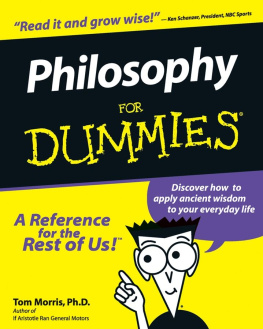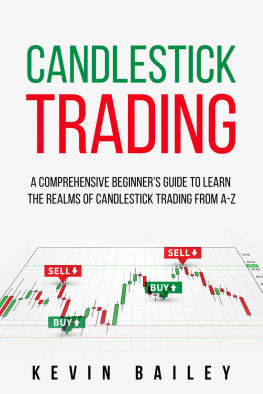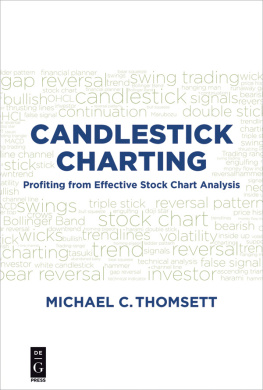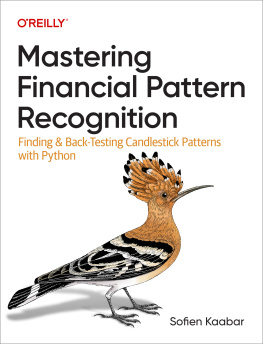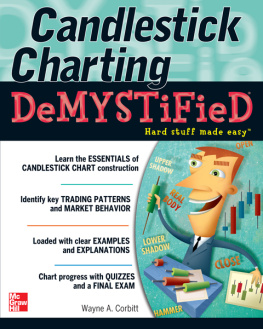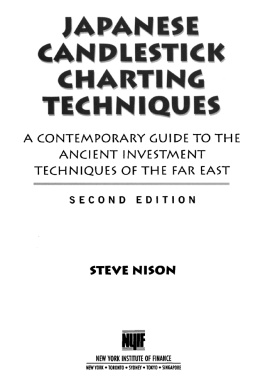CANDLESTICK CHARTING EXPLAINED WORKBOOK
CANDLESTICK CHARTING EXPLAINED WORKBOOK
Step-by-Step Exercises and Tests to Help You Master Candlestick Charting
GREGORY L. MORRIS

Copyright 2012 by The McGraw-Hill Companies, Inc. All rights reserved. Except as permitted under the United States Copyright Act of 1976, no part of this publication may be reproduced or distributed in any form or by any means, or stored in a database or retrieval system, without the prior written permission of the publisher.
ISBN: 978-0-07-174646-5
MHID: 0-07-174646-3
The material in this eBook also appears in the print version of this title: ISBN: 978-0-07-174221-4, MHID: 0-07-174221-2.
All trademarks are trademarks of their respective owners. Rather than put a trademark symbol after every occurrence of a trademarked name, we use names in an editorial fashion only, and to the benefit of the trademark owner, with no intention of infringement of the trademark. Where such designations appear in this book, they have been printed with initial caps.
McGraw-Hill eBooks are available at special quantity discounts to use as premiums and sales promotions, or for use in corporate training programs. To contact a representative please e-mail us at bulksales@mcgraw-hill.com.
This publication is designed to provide accurate and authoritative information in regard to the subject matter covered. It is sold with the understanding that neither the author nor the publisher is engaged in rendering legal, accounting, securities trading, or other professional services. If legal advice or other expert assistance is required, the services of a competent professional person should be sought.
From a Declaration of Principles Jointly Adopted by a Committee of the American Bar Association and a Committee of Publishers and Associations
TERMS OF USE
This is a copyrighted work and The McGraw-Hill Companies, Inc. (McGraw-Hill) and its licensors reserve all rights in and to the work. Use of this work is subject to these terms. Except as permitted under the Copyright Act of 1976 and the right to store and retrieve one copy of the work, you may not decompile, disassemble, reverse engineer, reproduce, modify, create derivative works based upon, transmit, distribute, disseminate, sell, publish or sublicense the work or any part of it without McGraw-Hills prior consent. You may use the work for your own noncommercial and personal use; any other use of the work is strictly prohibited. Your right to use the work may be terminated if you fail to comply with these terms.
THE WORK IS PROVIDED AS IS. McGRAW-HILL AND ITS LICENSORS MAKE NO GUARANTEES OR WARRANTIES AS TO THE ACCURACY, ADEQUACY OR COMPLETENESS OF OR RESULTS TO BE OBTAINED FROM USING THE WORK, INCLUDING ANY INFORMATION THAT CAN BE ACCESSED THROUGH THE WORK VIA HYPERLINK OR OTHERWISE, AND EXPRESSLY DISCLAIM ANY WARRANTY, EXPRESS OR IMPLIED, INCLUDING BUT NOT LIMITED TO IMPLIED WARRANTIES OF MERCHANTABILITY OR FITNESS FOR A PARTICULAR PURPOSE. McGraw-Hill and its licensors do not warrant or guarantee that the functions contained in the work will meet your requirements or that its operation will be uninterrupted or error free. Neither McGraw-Hill nor its licensors shall be liable to you or anyone else for any inaccuracy, error or omission, regardless of cause, in the work or for any damages resulting therefrom. McGraw-Hill has no responsibility for the content of any information accessed through the work. Under no circumstances shall McGraw-Hill and/or its licensors be liable for any indirect, incidental, special, punitive, consequential or similar damages that result from the use of or inability to use the work, even if any of them has been advised of the possibility of such damages. This limitation of liability shall apply to any claim or cause whatsoever whether such claim or cause arises in contract, tort or otherwise.
To
Laura
CONTENTS
PREFACE
After writing the third edition to Candlestick Charting Explained in 2006, I thought my candlestick writing days were over. Not so fast! After giving hundreds of lectures and presentations on the subject, I found that even though the book was quite thorough, many people still needed the academic approach to assist in their learning process. Moreover, I continue to witness a terrible misunderstanding about what candlesticks can offer a trader. I think this is so because some authors tend to overpromote their books and software, offering quick solutions to wealth. I dont even want to go there with an opinion on what I think of that approach. There is no magic in candlesticks, there is no ancient wisdom to glean, and there is nothing in candlesticks that you could not get from bar charts. Candlesticks just make it easier and certainly more visually appealing. Hence I created this book, which was designed not only to stand alone but also to be a companion to Candlestick Charting Explained. It serves as a study guide and boot-camp approach to learning. Its focus is on the salient and important points I made in the original book with an emphasis on a classroom environment complete with testing.
ACKNOWLEDGMENTS
I offer my sincere thanks and appreciation to Norman North for our 30 years of friendship and working together in the 1980s developing technical analysis software and, in particular, the CandlePower software that was the first commercially available software to identify Japanese candle patterns automatically. Wayne Corbitt needs special mention for all his effort in producing this book, along with numerous helpful suggestions and comments, he contributed greatly to
ENLISTMENT: GETTING READY FOR DUTY
By purchasing this workbook, you have voluntarily enlisted to participate in doing battle with the markets. The markets are living, morphing entities that feed off of human emotion and trader losses. It is my intention to provide you with the weapons necessary to trade what you see, to help you harness the power of candlestick analysis, and to avoid unnecessary losses. We will start with the basics of candlestick lines and patterns and then add weapons to our arsenal as we progress. First, however, let me step you through my journey that has brought us together at this point in time.
WHY BOOT CAMP?
In 1971, after graduating from the University of Texas with a bachelor of science degree in aerospace engineering, I was faced with a country in recession, and the marketplace for new engineers was scarce, so I joined the United States Navy to become a fighter pilot. Of course, that meant that I had to become an officer, and that, in turn, meant that I had to attend Officers Candidate School in Pensacola, Florida. No problem, right?
In October, 1971, I drove from Dallas, Texas, in my 1962 nonair-conditioned, faded-blue, four-door, standard transmission, six-cylinder Chevrolet Bel Air. This fine automobile had been with me since I was a junior in high school and had close to 175,000 miles. In the trunk, I had a box of my aerospace engineering books because I knew the Navy would be impressed and probably want me to teach others about aerodynamics, heat transfer, and boundary-layer theory. I started to include my golf clubs but later decided that I wouldnt have that much spare time between learning to be an officer, teaching aerodynamics, and engaging in all the social aspects of being a Navy pilot. Additionally, I had been a private pilot since 1967 and assumed that I knew all there was to know about flying airplanes. Wow, was I in for a shock!
Next page






